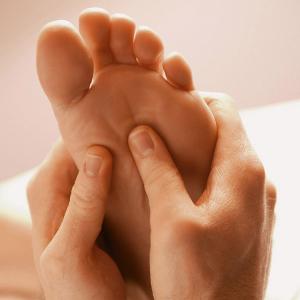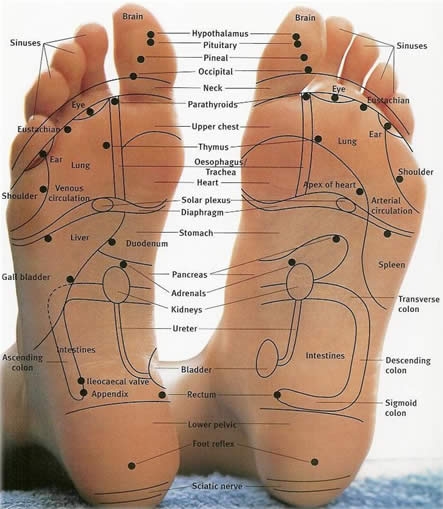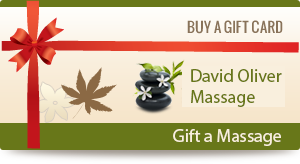How does reflexology work?
Reflexology is the ancient art of foot and hand massage which originated in China and which was also known to the Ancient Egyptians. It is believed that energy runs through the body in channels known as meridians and that massage of the feet and hands stimulates these energy channels, promoting healing and relaxation. Every part of the foot and hand corresponds to an area of the body, and massage of the feet and hands stimulates the corresponding part of the body so that receiving a reflexology massage is regarded as the equivalent of a full body massage!
The underlying theory behind reflexology is that there are “reflex” areas on the feet and hands that correspond to specific organs, glands, and other parts of the body. For example:
Applying pressure to these reflex areas can promote health in the corresponding organs through energetic pathways.
What will I feel?
Reflexology is suitable for all age groups, and it brings relief from a wide range of acute and chronic conditions by promoting self-healing.
After completing a course of reflexology treatment for a specific condition, many people find it beneficial to continue with regular treatments in order to maintain health and well-being. Most people find reflexology for the most part to be very relaxing.

|
Reflexology shouldn’t be painful. If you feel discomfort, be sure to tell the reflexologist. He or she should work within your comfort zone.
Some areas may be tender or sore, and the reflexologist may spend extra time on these points. The soreness should decrease with pressure.
If you’re ticklish, not to worry. The reflexologist applies firm pressure to the feet.
A typical treatment is 30 minutes to 60 minutes long and begins with a consultation about your health and lifestyle.
You are then asked to remove your shoes and socks and sit comfortably in a reclining chair or on a massage table. Otherwise you remain fully clothed.
The reflexologist will assess the feet and then stimulates various points to identify areas of tenderness or tension.
The reflexologist then uses brisk movements to warm the feet up. Then pressure is applied from the toes to the heel according to your comfort.
Lotion or oil may be used.
Most people feel calm and relaxed after a treatment. They may even feel sleepy. Occasionally, people feel nauseous, anxious, or tearful, but this is only temporary and is considered to be part of the healing process.
Precautions
If you’re pregnant, talk with your doctor first and let the reflexologist know.
Be sure to give the reflexologist a complete and accurate health history.
If you have foot ulcers, injury, or blood vessel disease such as blood clots, consult your doctor before having reflexology.

Benefits of Reflexology
Reflexology is a popular alternative therapy. It promotes relaxation, improves circulation, reduces pain, soothes tired feet, and encourages overall healing.
Reflexology is also used for post-operative or palliative care. A study in the American Cancer Society journal found that one-third of cancer patients used reflexology as a complementary therapy.
For most of the people, reflexology starts showing benefits immediately once, the reflexology professional’s hand starts massaging the foot. However, few experience tiredness, weakness, need to urinate, and so symptoms; that too vanishes in the next session of reflexology massage and there after they can reap the benefits.
Reflexology is recommended as a complementary therapy and should not replace medical treatment.
Some benefits of reflexology include:
Conditions treated with reflexology:
This gentle massage therapy may bring relief from a wide range of both acute and chronic conditions. Reflexology has been showing to be effective and assist self-healing in conditions such as:
Reflexology may also be effective with relief from Allergies, Asthma, Blood Pressure abnormalities, Bowel disorders, Eczema, Frozen Shoulder, Gynecological problems, Knee pains, Muscle tension, Neck strain, Respiratory disorders, Sinusitis, Thyroid problems and many more.
Reflexology Research
A scientific explanation is that the pressure may send signals that balance the nervous system or release chemicals such as endorphins that reduce pain and stress.
Research has shown the specific techniques of reflexology to be effective and beneficial in many ways. A survey of 170 reflexology studies from 21 countries shows that reflexology is effective, impacting a variety of physical and psychological concerns.
Reflexology:
Creates relaxation: From the moment the reflexologist’s hands start their work, the relaxation begins as shown in research using EEG brain activity. All together, 24 studies demonstrate reflexology’s relaxation effects.
Reduces pain: Pain reduction following reflexology work is documented in 27 studies including research showing impact on individuals of all ages and health states.
Ameliorates health concerns: Research shows that reflexology work helps indiviuals of all ages with some 78 health concerns ranging from aggressive behavior in children to urinary concerns of the elderly.
Improves blood flow: Separate studies show that reflexology work increases blood flow to the feet, brain, kidneys and intestines.
Aids post-operative recovery: Reflexology work aids recovery after surgery as shown by several studies, reducing pain and lessening the use of post operative analgesics. Impact on physiological measures (e. g. blood pressure and cholesterol; measurements by ECG, EEG, and MRI)
Enhances medical care: Reflexology helps where nothing else can for many: phantom limb pain sufferers, neuropathy patients, and hemodialysis patients to name a few.
Benefits mental health: Research demonstrates that reflexology can reduce depression (11 studies) and anxiety (9 studies).
Complements cancer care: Pain, nausea, vomiting, and/or anxiety eased for chemotherapy patients following reflexology work as shown by16 studies fom 7 countries.
Eases pregnancy, delivery and post-partum effects: Women who received reflexology experienced shorter labor times and used less analgesia. In addition, reflexology showed a positive impact on postpartum depression, anxiety, urination and bowel movements.
In general terms, the benefits of reflexology have to do with the reduction of stress. Because the feet and hands help set the tension level for the rest of the body, they are an easy way to interrupt the stress signal and reset homeostasis, the body’s equilibrium.
Reflexology is a complement to standard medical care. It should not be construed as medical advice. It should not be a replacement to medical help. Please use it wisely. We care about your safety.
Book a Massage Online

to Top
